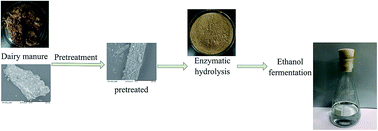Bio-ethanol production by Zymomonas mobilis using pretreated dairy manure as a carbon and nitrogen source
Abstract
Dairy manure contains high levels of cellulose, hemicellulose and a nitrogen source. These properties make dairy manure a potential biomass source for ethanol production. In this study, a dilute NaOH pretreatment and enzymatic hydrolysis were carried out for the degradation of lignocellulose from dairy manure. The response surface method and Box–Behnken design were first applied in order to optimize the NaOH pretreatment. Under the optimization conditions, 21.14 g L−1 of glucose and 9.48 g L−1 of xylose were obtained from continuous enzymolysis. The maximum ethanol concentration achieved reached 10.55 g L−1 when using ethanologenic Zymomonas mobilis without an additional nitrogen source. This produced a 71.91% ethanol yield from manure hydrolysate medium. These results demonstrate the economic benefits of using nitrogen from a dairy manure source for balancing the C/N ratio, without the need for an additional nitrogen source. The results from this study could extend beyond cellulosic ethanol for the production of other chemicals.



 Please wait while we load your content...
Please wait while we load your content...